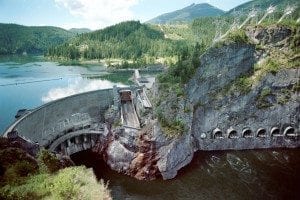Modernizing Hydropower
Hydropower has generated clean, affordable electricity for more than 100 years, but it has yet to realize its full potential. A study from Navigant Consulting shows that nearly 9,000MW of new capacity could be added through modernizing existing hydropower facilities.
Modernization projects upgrade turbines and other equipment, expanding the capacity and lifespan of existing hydropower facilities.
The process of upgrading America’s hydropower facilities has already begun, with great success. In November 2009, the Department of Energy announced that it would award up to $30.6 million in Recovery Act funding for seven hydropower projects that modernized existing facilities and quickly generated jobs in local communities.
The selected projects will increase electric generation by an estimated 187 GWh per year, at an average cost of less than 4 cents per kWh. And the projects are not only low cost, they are environmentally friendly – the incremental energy from the seven hydropower plants will result in a reduction in carbon dioxide emissions of over 110,000 tons per year compared to electricity from the average U.S. grid, DOE estimates. Using the latest technologies to generate power also benefits wildlife, helping to preserve ecosystems and increase fish populations.
“One of the best opportunities we have to increase our supply of clean energy is by bringing our hydropower systems into the 21st Century. With this investment, we can create jobs, help our environment and give more renewable power to our economy without building a single new dam.”
— Energy Secretary Steven Chu, Nov. 4, 2009
The seven projects selected by DOE are:
Alabama Power Company will receive up to $6 million for a project in Mitchell, AL, that will upgrade four units at three hydroelectric plants on the Coosa River, increasing generation by 36,087 MWh annually.
Alcoa, Inc. will receive up to $13 million for a project in Robbinsville, NC, to replace four 90-year-old Francis Turbines with four new high-efficiency stainless steel turbines, generators, and transformer at its Tapoco Cheoah plant. Annual generation would increase by 95,000 MWh.
Tacoma Power will receive up to $4.67 million for a project in Potlatch, WA, where the PUD will add two 1.8 MW Francis Turbines to the existing Cushman No. 2 Dam, increasing annual generation by 23,500 MWh. The project will incorporate an upstream fish collection pool to enable reintroduction of native fish above the dam for the first time since the 1920s.
The City of Boulder, CO will receive up to $1.18 million for a project in Boulder, CO. The city is upgrading its 100-year-old Boulder Canyon Hydroelectric Project by replacing two older turbines with a single, high-efficiency unit.
Energy Northwest will receive as much as $800,000 for a project in Packwood, WA. Adding a new turbine to its Packwood Lake Hydroelectric facility will increase generation by 5,868 MWh while also benefiting the downstream ecosystem and increasing fish populations.
North Little Rock Electric Department will receive up to $450,000 for a project in Little Rock, AR. The electric department plans to install a device at its facility on the Arkansas River to clear debris currently obstructing the intake and allow the facility to operate consistently at near peak efficiency and significantly reduce the high cost of dredging.
Seattle Sees Positive Energy, Economic, and Environmental Benefits Thanks to CREBs

Seattle City Light is undertaking an upgrade of its 1050 MW Boundary Hydroelectric Project on the Pend Oreille River in Washington State, with the assistance of federal Clean Renewable Energy Bonds (CREBs). The investment will allow the public power utility to increase generation, create new jobs, and improve environmental performance.
With $53 million of low-interest bonds, SCL will complete two generator and turbine refurbishments, as well as replace two generator step-up transformers. The end result is expected to add 40 MW of new capacity to the project, enough to provide about 4,000 homes with access to clean, reliable hydropower. Using CREBs will save the utility $24 million of interest payments over the life of the bond – savings that ensure hydropower remains an affordable electricity resource for SCL’s ratepayers.
The economic benefits of the work are not just being felt in Washington State. In addition to the four temporary employees needed at SCL to complete the upgrades, contracts signed resulted in up to 15 contract employees to provide installation services for the generators and transformers. The turbine runners for the upgrade are American-made, manufactured right in Pennsylvania by Weir American Hydro before being shipped on a three week trek across 13 states to Boundary.
The aquatic life of the Pend Oreille River will also enjoy improved habitat as a result of the upgrade. The new turbines will reduce the total dissolved gas in the tailrace waters of the project, improving water quality for fish that call Pend Oreille home, including ESA-listed Bull Trout.
Seattle City Light is just one of the success stories of the CREBs Program; many public utilities are employing CREBs to bring additional hydropower and other renewable energy technologies online. CREBs allow tax-exempt entities to secure financing for projects by allowing them issuing bonds that are financed through tax credits paid out to the bond holder. Since these entities do not qualify for tax incentives like the production tax credit (PTC), CREBs are vital.
Learn more about CREBs and other policies that are incentivizing expanded hydropower development.


